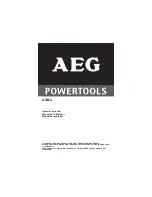
4
Safety rules for laser lights
The laser light/laser radiation used in the GMC REDEYE®
system is Class 1 with maximum 1mW power and 650nm
wavelengths. These lasers do not normally present an
optical hazard, although staring at the beam may cause
flash blindness.
Warning.
Do not stare directly at the laser beam. A
hazard may exist if you deliberately stare into the beam,
please observe all safety rules as follows;
•
The laser shall be used and maintained in accordance
with the manufacturer’s instructions.
•
Never aim the beam at any person or an object other
than the work piece.
LASER LIGHT. LASER RADIATION
Do not stare into beam.
Only turn laser beam on when tool
is on work piece. Class 1 laser product
•
The laser beam shall not be deliberately aimed at
personnel and shall be prevented from being directed
towards the eye of a person for longer than 0.25s.
•
Always ensure the laser beam is aimed at a sturdy work
piece without reflective surfaces. i.e. wood or rough
coated surfaces are acceptable. Bright shiny reflective
sheet steel or the like is not suitable for laser use as
the reflective surface could direct the beam back at the
operator.
•
Do not change the laser light assembly with a different
type. Repairs must only be carried out by the laser
manufacturer or an authorised agent.
Caution.
Use of controls or adjustments or performance of
procedures other than those specified herein may result in
hazardous radiation exposure.
Please refer to the relevant Australian standards, AS 2397
and AS/NZS2211 for more information on Lasers.
General safety instructions
To use this tool properly, you must observe the safety
regulations, the assembly instructions and the operating
instructions to be found in this Manual. All persons who
use and service the machine have to be acquainted with
this Manual and must be informed about its potential
hazards. Children and infirm people must not use this
tool. Children should be supervised at all times if they
are in the area in which the tool is being used. It is
also imperative that you observe the accident prevention
regulations in force in your area. The same applies for
general rules of occupational health and safety.
Warning.
When using power tools, basic safety
precautions should always be taken to reduce the risk of
fire, electric shock and personal injury. Also, please read
and heed the advice given in the additional important
safety instructions.
1. Keep the work area clean and tidy.
Cluttered work
areas and benches invite accidents and injury.
2. Consider the environment in which you are working.
Do not use power tools in damp or wet locations.
Keep the work area well lit. Do not expose power tools
to rain. Do not use power tools in the presence of
flammable liquids or gases.
3. Keep visitors away from the work area.
All visitors
and onlookers, especially children and infirm persons,
should be kept well away from where you are working.
Do not let others in the vicinity make contact with the
tool or extension cord.
4. Store tools safely.
When not in use, tools should be
locked up out of reach.
5. Do not force the tool.
The tool will do the job
better and safer working at the rate for which it was
designed.
6. Use the correct tool for the job.
Do not force small
tools or attachments to do the job best handled by a
heavier duty tool. Never use a tool for a purpose for
which it was not intended.





































